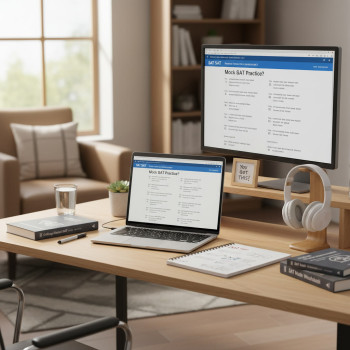How Often Should You Take Digital SAT Practice Tests? A Friendly Guide for Busy Students
If you’ve ever wondered whether practicing for the Digital SAT every day will magically boost your score — or whether one practice test a month is enough — you’re not alone. The question of frequency comes up again and again: How many full-length practice tests should you take, and how often should you sprinkle in shorter drills, section practices, and review sessions? The honest answer isn’t a single number that fits everyone. But you can build a smart, flexible rhythm that fits your schedule, reduces test-day anxiety, and helps you improve steadily.
Why frequency matters more than you think
Practice tests are more than just score-checking tools. Each timed, full-length practice test gives you:
- Realistic pacing experience for the Digital SAT format and the Bluebook environment.
- Insights into which question types slow you down or cause careless mistakes.
- Actionable diagnostics to inform focused study sessions (rather than practicing randomly).
- Opportunities to build mental stamina and test-day routines.
Too few practice tests and you risk being surprised by timing and question flow. Too many, or poorly spaced practice tests, and you’ll burn out — or worse, practice without learning because you don’t review mistakes properly. The sweet spot balances frequency with thoughtful review and targeted practice.
Key principles to decide your ideal frequency
- Quality over quantity: An analyzed practice test is worth more than three ignored ones. Spend at least as much time reviewing as you do taking the test.
- Start early and build gradually: Frequent short practice early in your prep builds skills; full-length tests become more frequent as test day approaches.
- Cycle practice and recovery: After an intense full-length test and review, schedule lighter days to focus on weak areas.
- Use diagnostic data: Let your performance guide frequency. Struggling in a section? Add targeted drills before your next full test.
- Simulate test conditions: At least a few practice tests should be taken under full test conditions to build stamina and reduce surprises on test day.
A practical, phased schedule you can adapt
Below is a flexible schedule broken into three phases. Pick the phase that fits how far you are from test day and how much baseline preparation you already have.
Phase 1 — Foundation (3+ months out)
Goal: Build content knowledge and learn test mechanics without wearing yourself out.
- Full-length practice tests: 1 every 3–4 weeks.
- Short practice sessions: 3–5 short (30–60 min) focused sessions per week targeting specific skills (algebra, grammar rules, data interpretation, reading strategies).
- Review routine: For every full-length test, spend 2–3 times the test duration reviewing errors and categorizing mistakes (concept gap, careless error, time management).
Phase 2 — Intensify (6–8 weeks out)
Goal: Convert knowledge into consistent performance and build timing strategies.
- Full-length practice tests: 1 every 10–14 days.
- Targeted practice: 4–6 sessions per week, including mixed-section timed blocks to practice transitions and pacing.
- Simulations: At least one practice taken on the Bluebook app under full test-day conditions (device, timing, breaks).
Phase 3 — Peak & Polish (2 weeks out)
Goal: Peak mentally and physically while fixing last-minute weak spots.
- Full-length practice tests: 1–2, with the final one 7–10 days before test day to identify tiny adjustments.
- Light review: Brief, targeted sessions to solidify formulas, grammar rules, and pacing strategies. Avoid learning brand-new major topics in this window.
- Recovery: Prioritize sleep, healthy meals, and low-stress routines — your brain needs recovery as much as practice.
How many full-length practice tests is “enough”?
If you’re trying to pin a number down, here’s a realistic range based on the phases above and common student experiences:
| Prep Time Before Test | Recommended Full-Length Tests | Notes |
|---|---|---|
| 3+ months | 4–6 | Spread out; focus on review after each test. |
| 6–8 weeks | 3–5 | Increase frequency and simulation realism. |
| 2 weeks | 1–2 | Final tune-up; avoid fatigue. |
These numbers emphasize thoughtful practice plus review. If you have limited time, one well-reviewed test per month paired with weekly targeted practice can still produce meaningful gains. If you have a lot of time and aim for a substantial jump, prioritize regular tests and immediate, deep review.
Short practice vs. full-length tests: how to combine them
Shorter, frequent sessions are where most gains happen. Use them to:
- Strengthen weak content areas (quadratic equations, comma rules).
- Practice discrete skills (data analysis in 15 minutes, sentence correction drills).
- Train pacing with mini-sections (e.g., two 25-minute practice reading passages under time).
Think of short practice as building bricks and full-length tests as assembly practice. Don’t skip either.
How to review a practice test — the secret sauce
Taking a test without reviewing is like running a race and never checking the finish-line clock. A structured review turns practice tests into measurable improvement.
Step-by-step review workflow
- Score and annotate: Mark correct vs. incorrect. For each incorrect or guessed question, write down why you missed it.
- Classify the error: Concept misunderstanding, careless mistake, vocabulary gap, or pacing issue.
- Create a mini-action plan: For each error type, assign 1–3 focused drills to do before your next practice test.
- Track progress: Keep a spreadsheet or notebook of error types and improvements over time.
- Re-test the same skill: After targeted practice, retake a small set of similar questions to confirm learning.
Example: Turning a 12-point drop into a 40-point gain
Imagine you take a practice test and drop 12 points mainly because you ran out of time on two math sections and made careless mistakes on reading questions. Your review may reveal:
- Three question types that consistently trip you up (multi-step algebra, chart interpretation, inference-heavy reading passages).
- Pacing pattern: you spend extra time on the first three math problems and feel rushed later.
Your action plan could be: two weeks of timed math blocks focusing on early problems, ten targeted reading passages practicing inference questions, and one full-length test to measure improvement. Often this focused cycle yields much larger gains than taking multiple unreviewed full-length tests.
Personalization: make the frequency your own
No two students are the same. Your ideal rhythm depends on factors like baseline score, target score, school workload, extracurriculars, and learning preferences. Here are rules-of-thumb to personalize:
- If you’re 150+ points from your goal: prioritize content mastery with 1 full-length test per 3–4 weeks plus heavy targeted practice.
- If you’re 50–150 points away: increase to one full-length test every 10–14 days and a focused review routine.
- If you’re within 50 points: do 1–2 final simulations in the month before your test and spend the rest of your time on polishing strategies and avoiding new heavy content.
How tutoring fits in naturally
One-on-one guidance can speed up this personalization. Tutors can analyze your practice-test diagnostics and suggest exactly which question types to attack, how to adapt pacing, and how to structure review sessions. Sparkl’s personalized tutoring, for example, offers tailored study plans, 1-on-1 guidance, expert tutors, and AI-driven insights that help make every practice test more meaningful. When used selectively — especially in Phase 2 — tutoring helps avoid wasted practice and accelerates score improvement.
Common pitfalls — and how to avoid them
- Pitfall: Taking too many tests back-to-back. Fix: Space tests so you can analyze and act on results.
- Pitfall: Focusing on score-only rather than understanding mistakes. Fix: Categorize and remediate errors, then re-test similar problems.
- Pitfall: Ignoring test conditions (device, breaks). Fix: At least two practice tests should simulate your actual test-day environment on Bluebook with the same device and timing.
- Pitfall: Random practice without a plan. Fix: Use data from practice tests to build a targeted weekly plan.
Sample 10-week schedule for a student aiming for a meaningful score jump
This sample calendar assumes regular school demands and about 6–8 hours per week of SAT-focused work.
| Week | Activity | Why it helps |
|---|---|---|
| 1 | Baseline full-length test + 3 targeted short sessions | Establish baseline and immediate weaknesses |
| 2 | Focused content blocks (math fundamentals, grammar drills) | Bridge foundational gaps |
| 3 | Timed section practice + review | Improve pacing and accuracy |
| 4 | Full-length test + deep review | Measure progress; adjust plan |
| 5–7 | Rotate targeted practice (weak areas) + one full-length test every 2 weeks | Consolidate gains |
| 8 | Full-length test on Bluebook under test-day conditions | Build comfort with digital interface |
| 9 | Light targeted practice, error polishing | Sharpen strategies without fatigue |
| 10 | Final practice test (7–10 days out) + rest | Final tweaks; recovery |
Practical tips to get the most from every practice test
- Always take notes on timing: where did you slow down and why?
- Simulate test-day environment occasionally: same device, headphones (if using text-to-speech), and scheduled breaks.
- Set clear goals for each practice test (e.g., reduce careless errors by half, hit pacing targets on math).
- Use a study journal to track small wins — seeing progress motivates you more than raw scores.
- Consider a tutor for targeted guidance. Tutors can accelerate remediation by showing efficient strategies for recurring error types. Sparkl’s tutoring pairs that tailored expertise with AI-driven insights to make practice tests more actionable and time-efficient.
Final thoughts: rhythm beats intensity
There’s no magic number that applies to every student. The ideal frequency of Digital SAT practice tests is one that you can sustain, that produces honest data, and that leaves space for careful review and targeted practice. In short:
- Start early, take fewer tests at first, and focus on review.
- Increase frequency as test day nears, but prioritize quality review over raw test counts.
- Use shorter, focused practice sessions to build skills between full-length tests.
- Simulate test conditions at least a couple of times so nothing on test day feels new.
Treat practice tests like conversations with the test — each one tells you where you’ve improved and where there’s more work to do. With a steady rhythm, thoughtful review, and the occasional expert nudge (like personalized tutoring and tailored study plans), you’ll walk into test day confident, calm, and ready to perform.
Ready to plan your practice schedule? Start with one full-length test this week to set your baseline. Then build a rhythm that fits your life: consistent, thoughtful practice beats last-minute cramming every time.
Want a shortcut?
If you’d like a personalized schedule based on your baseline test, current commitments, and target score, consider scheduling a session with a tutor who can craft a tailored plan and help interpret your practice-test diagnostics. Personalized guidance — whether from a skilled tutor or an AI-informed coach — can save time and sharpen results, especially in the weeks when every practice test counts the most.
Good luck — and remember: steady, smart practice is the simplest path to a stronger SAT score.














No Comments
Leave a comment Cancel